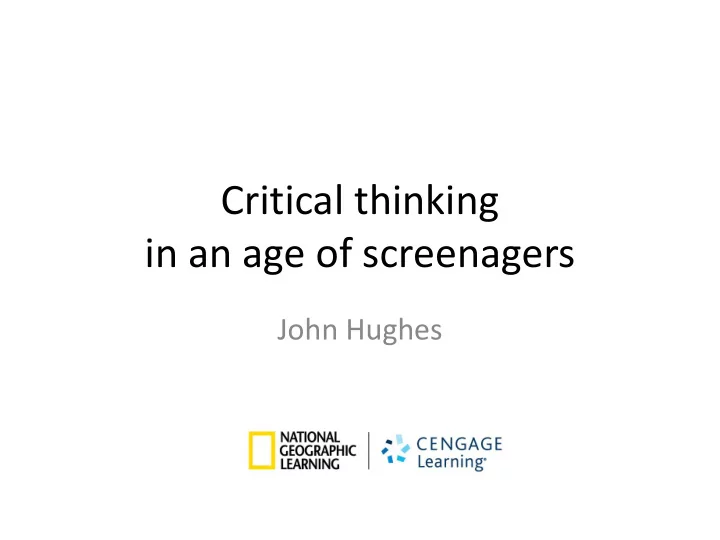

Critical thinking in an age of screenagers John Hughes
A timeline of critical thinking… 1941 Edward M. Glaser 1956 Bloom’s Taxonomy 2000 Anderson & Krathwohl
“Are students graduating from school really ready to work?” “No, not really.” • Oral and written communication • Professionalism and work ethic • Teamwork and leadership • Critical thinking and problem solving Survey of 400 HR Managers
A working definition
“Social media and the internet has reduced our ability to concentrate for long periods of time.”
1 I’m not interested in this topic. 2 I agree. It’s true. 3 I disagree. It’s false. 4 I’m not sure. 5 I agree up to a point but I also disagree. 6 I agree / disagree because… 7 I agree / disagree for a number of reasons but I’d also like more evidence.
1 You don’t need to be interested but have an opinion. 2 and 3 You have a strong opinion but can you give reasons for your opinion? 4 and 5 This is a safe response but critical thinkers need to be active in the discussion. 6 Good. You have a reason for your opinion. 7 Great! You have reasons for your opinion and you want more information.
exercise is good for you I think that travel broadens the mind I agree that our grandparents’ lives were easier I don’t agree living in the country is better than the because… that city I’m not sure the internet has improved that communication people spend too much time on Facebook
Critical thinking skills involve • Identifying evidence • Asking critical questions • Challenging assumptions • Identifying perspectives • Solving problems
Identifying evidence
RELIABILITY 1 = Not a reliable source 2 = It might be credible but I’d have to check the information in another source as well 3 = It’s usually a very credible source of information • An article in a newspaper • A post on Facebook • A video on YouTube • A published book by a qualified specialist on the subject • An entry on Wikipedia • A documentary on TV with interviews with real people
How vague or accurate are these sentences? 1) The group who had used Facebook did 25% better in the tests. 2) Parents spend less time with their children than they did a decade ago. 3) The scientists did a study on 14 adults aged between 68 and 91 who had either never used the site or used it less than once a month. 4) Studies also show that children taught via video broadcasts and DVDs do not learn as well as when they did when given lessons by a real teacher.
1 Some tribes offer courses in the language to the younger adults and children. 2 ...the good news is that some of these people are keeping their culture and language alive. 3 The Salish tribe is an excellent example of how schools can help. 4 There are 30 students learning the tribal language in the daytime school. 5 It is schools and projects like these which – hopefully - might save languages for the future.
Asking critical questions
1 Answer questions 1 to 6 with one word from the text. 2 Find the sentence in paragraph 2 which summarises the writer’s main argument 3 Underline emotive adjectives in the text and say what they tell us about the author’s attitude. 4 Read the article and write down the events before during and after the fire in the correct order. 5 Look at these statements and say if they are true (T) or false (F) according to the text. 6 The article lists both advantages and disadvantages of foreign travel. Find and underline adjectives that give a positive view of it and adjectives that are more negative. Adapted from Dummett, P. (2013) How to write Critical Thinking Activities ELTeachers2Writers
Challenging assumptions
Identifying perspectives
You are either a local… • hotel owner • sun cream manufacturer • environmentalist • recruitment company for seasonal workers Use this photo of the local beach in an advert for your organisation or business. Write a slogan to go with the picture.
1 ‘Our company is so cheap when it comes to bonuses!’ 2 ‘My previous meetings with the client have been somewhat difficult .’ 3 ‘This approach to design is ancient .’ 4 ‘He’s a real workaholic .’ 5 ‘This new management’s attitude is unbelievable .’ 6 ‘Since he was promoted, he’s become so big-headed .’
Solving problems
“Yes, and…” “Yes, but…” 29
Make it larger Make it smaller Make it simpler Make it more complicated Make it more colourful Make it more appealing (to young people) Make it easier to access Make it more exclusive 30
Critical thinking skills involve • Identifying evidence • Asking critical questions • Challenging assumptions • Identifying perspectives • Solving problems
Critical thinking activities in the English classroom will include… • Lots of questions and discussion • Reading and listening for the argument and the evidence • Language analysis and evaluation • Role playing and problem solving tasks • Case studies
www.ngllife.com
john@hugheselt.com www.elteachertrainer.com www.elteachertrainer.com/critical-thinking-in-elt www.ngllife.com Thanks for taking part!
Recommend
More recommend